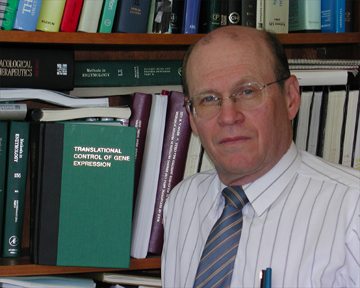Understanding and normalizing the function of brain neurons in autism has moved a step closer. Scientists conducting a gene study reversed behaviours associated with the condition in adult mice using compounds previously developed to treat cancer.

Researchers in Canada at McGill University and the University of Montreal have identified a link between the overproduction of certain brain proteins and symptoms of ASD.
The findings led them to reverse autism-like behaviours in mice by stopping the overproduction of these proteins. One of the strategies used to reverse autistic behaviours in the mice was to employ an anti-cancer compound to block protein synthesis.
Lead author of the study, Dr Nahum Sonenberg (pictured), of McGill University’s Goodman Cancer Research Centre, has long studied abnormal protein synthesis in cancer.
The Centre’s research team was working with mice that had been genetically altered to be susceptible to cancer, and while doing so found mechanisms similar to those associated with autism.
Dr Sonenberg said: “My lab is dedicated to elucidating the role of dysregulated protein synthesis in cancer etiology. However, our team was surprised to discover that similar mechanisms may be implicated in the development of ASD.”
The McGill University researchers who reversed autism behaviours in mice began their research by inducing specific changes in brain gene expression. They genetically engineered mice so that they lacked the gene EIF4EBP2. Mice lacking this gene exhibit autism-like symptoms, including poor social interaction, altered communication and repetitive behaviours.
They discovered that a group of proteins called neuroligins (NLGNs) proliferate in the absence of the EIF4EBP2 gene. Neuroligins are crucial for the regulation of connections called synapses between neuronal cells in the brain.
The researchers found abnormal production of neuroligins increases synaptic activity between neurons, causing an imbalance between excitation and inhibition in brain cells. Previous research indicated that such imbalances are behind some of the core symptoms of autism.
Crucially, the team showed that the effects of deleting EIF4EBP2 and creating the autism-like symptoms in the mice can be reversed. Afterwards, the mice showed none of the autism-like symptoms that they previously exhibited.
In addition to administering the cancer compound to the mice, another strategy the researchers employed to reverse their autistic symptoms was to use non-replicating viruses as vehicles to put a break on exaggerated synthesis of neuroligins.
The new mice model of autism means scientists have a better understanding of how certain brain signaling pathways underlie ASD and cause its behavioural symptoms.
However, Dr Sonenberg cautioned against interpreting the results as a sign that a treatment for ASD is imminent. While the study demonstrated that a drug therapy is possible in principle, he said that the drugs used in the experiments would be too toxic to use on people affected by autism.
Professor Jean-Claude Lacaille of the University of Montreal was upbeat about longer-term prospects, speaking of the research leading to a potential treatment. He said: “The fact that the balance can be affected suggests that there could be potential for pharmacological intervention by targeting these mechanisms.”
Published: 25 November 2012

















